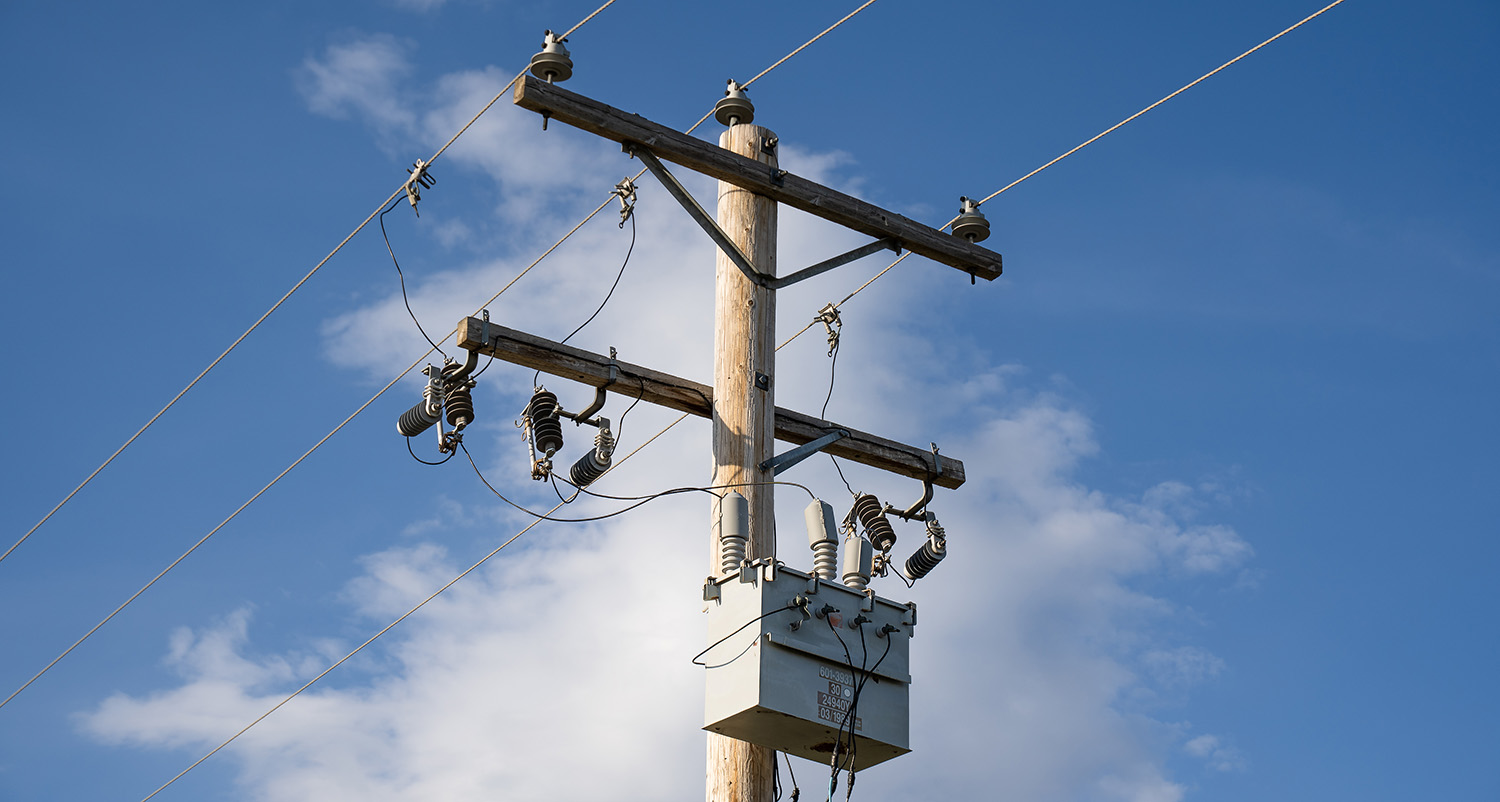History and types of poles
Utility poles first appeared on the North American landscape in the mid-19th century. Their purpose was to support overhead telegraph wires. As populations and electricity usage increased across the continent, these poles were outfitted with insulators and electric power distribution lines were added to their function. At the turn of the 20th century, cross arms were attached to poles to support the growing demand for electrical and telephone signal transmissions to urban and rural communities.
Underground distribution systems are 21st-century alternatives to utility poles, particularly in residential neighbourhoods. They are typically unaffected by weather and other environmental hazards. Underground distribution systems also allow for increased reliability and a less cluttered visual landscape in urban settings.
In terrain and communities where underground distribution is not an option, above-ground poles continue to serve an essential role in transmitting electricity where it is needed. This requires three types of poles:
- Transmission – transport primary, high voltage power between power stations
- Distribution – transmit secondary, lower voltage power that has been converted for everyday use directly to businesses and homes
- Public service – transmit varied levels of power to public service fixtures such as street lighting and traffic, equipment
Depending on requirements and available resources, utility poles vary in both size and the material used to make them. The standard utility pole in North America is 30- to 60 feet high but can reach as high as 150 feet along major roads and highways. They’re buried approximately 6 feet underground, often with screw piles and secured with guy wires. Terrain determines spacing, but poles are typically placed 125 feet apart in urban areas and 300 feet in rural areas. Poles are usually owned by one utility which then leases space for other cables, which can include electrical, fibre optic, communications and related utilities such as transformers and street lights.
In terms of materials used for pole construction, wood continues to be a prevalent source. However, a number of other materials have emerged that are highly effective for pole construction, meeting unique weather, geographical and utility requirements.
Wood poles
With an estimated 160 million wood utility poles in use across North America, this material continues to be the workhorse in overhead line construction today. This is largely because it is readily available, lightweight, strong and non-conducting. It is also very durable when treated with preservatives.
Given the essential transmission function they play, however, not just any wood will do. Wood poles used in North America are selected from native trees, including Western Red Cedar, Lodgepole Pine, Red Pine, Douglas Fir or Southern Yellow Pine. These trees must have reached the required height and diameter and be relatively straight. Only about 7% of trees meet this criteria.
To become utility poles, these trees are pressure-treated with preservatives to strengthen them and to minimize the risk of fungi, rot and damage caused by wildlife5. The lifespan of a wood utility pole is 25-50 years.
Wood utility poles are excellent insulators with a high mass-to-energy absorption rate. They are low relative weight and cost and easy to climb/access to service without heavy equipment. On the other hand, they are prone to damage and require significant energy to harvest, manufacture and transport them6.
Concrete poles
Concrete utility poles are manufactured using a centrifugal process resulting in high-density concrete and a hollow raceway inside the pole. This process reduces weight and creates a smooth conduit and internal routing for electrical cables. As a result of this process, concrete poles are durable and highly resistant to weather conditions. They’re also extremely resistant to rot and wildlife damage.
Concrete poles offer insulating properties similar to wood but with a much higher load capacity. They require minimal maintenance and are designed to provide reliable strength and durability over a 50+ year lifespan. They are also heavy and difficult to handle and will not flex in high winds, making them prone to cracking. Once a concrete pole weakens, it poses a significant safety risk. Lastly, the cost of manufacturing concrete poles is prohibitive if not made on site and once manufactured, they can’t be easily modified.
Composite poles
Composite utility poles are made from a combination of materials ranging from reclaimed wood or medium-density fiber to plastics and specially-woven fibreglass, resins and UV protection and pigments. The result is a non-conductive pole that offers several unique advantages.
Composite poles are engineered for an extremely high strength-to-weight ratio and can be fabricated in sections to achieve lengths of up to 95 feet. Composite poles can be assembled during installation, making them easier to transport and install in remote areas or coastal environments. These poles are effective insulators and are robust, rot-proof and impervious to damage caused by wildlife. Because they are less likely to corrode over time, composite poles have an 80+ year lifespan.
Even with these advantages, composite poles are not as easy to install as wood, and the manufacturing process requires large quantities of energy. In addition, since the mass-to-energy absorption rate is extremely low, they are not a good option for utility lines that are near roads and forests.
Steel poles
Steel utility poles are designed to be wood pole equivalents that can be utilized in any application wood poles of the same class can be used. They offer design flexibility, strength, low weight, predictability and superior life cycle costs. They are also highly resistant to insects, woodpeckers, rot, and fires and are 100% recyclable and toxin-free.
There are significant drawbacks to steel poles. One is that they are inflexible and prone to rust, decreasing their life expectancy. Also, if a line goes down and live wire touches the steel, the pole becomes a dangerous conductor.
Overhead utilities are required in a wide range of environments and conditions, so it is advantageous to have options to choose from when it comes to the poles that support them. At ORBIS, our pole line hardware is suited to all pole types. While our hardware is primarily designed for wood pole installations, it is also adaptable to fiberglass and concrete. ORBIS also offers customizable solutions to meet standards and specifications. As with everything we manufacture at ORBIS, our pole line hardware is designed and manufactured to the highest standards to uphold the industry demand and life cycle. Additionally, our ‘always in-stock’ philosophy ensures that you can count on ORBIS to provide you with the safest, highest quality pole line hardware when and where you need it.
–
Sources
- “What’s on a Utility Pole?”. My Florida Public Service Commission. (n.d.)
- “Utility Pole Materials – Introduction”. Pole Saver Blog. 9 July 2019.
- Zabel, R. A., Morell, J. J. “Decay problems associated with some major uses of wood products”. 2020.
- “How Poles Are Made: From Forest to Decades of Service”. Woodpoles.org (n. d.).
- “The Major Limitations of Wood Poles”. Engineeringall.com. 16 November 2021.
- “Hydro Poles: Where do they Come From?”. Hydro Ottawa. 18 August 2020.
- Muthike, G. & Ali, G. “Concrete vs Wooden Poles: Effects of the Shift to Concrete Poles on Tree Growers”. Kefri.org. 2021.
- “5 Reasons The World Needs To Switch To Composite Utility Poles”. Rock West Composites. (n.d.)
- “The Low Down on Different Types of Utility Poles”. Critter Guard. (n.d.)
- Lacoursiere, B.“ Steel Utility Poles: Advantages and Applications”. Rural Electric Power Conference (Cat. No. 99CH36302). 1999.

